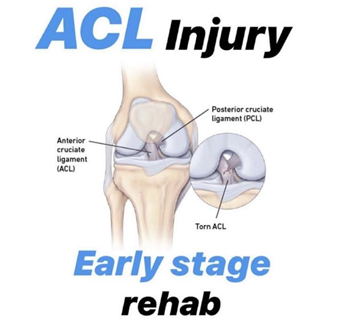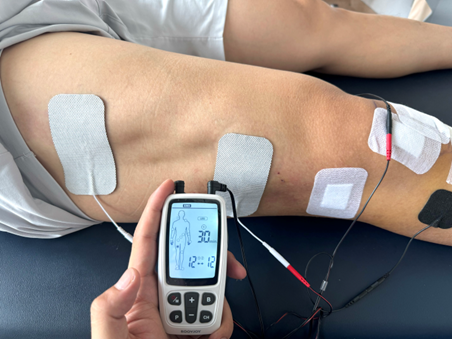The device shown in the figure is R-C4A. Please select EMS mode and choose either leg or hip. Adjust the intensity of the two channel modes before starting your training session. Begin by performing knee flexion and extension exercises. When you feel the current being released, you can apply force against the muscle group or along the direction of muscle contraction. Take a break when your energy is depleted, and repeat these training movements until you finish.

1. Electrode Placement
Identifying Muscle Groups: Focus on the quadriceps, especially the vastus medialis (inner thigh) and vastus lateralis (outer thigh).
Placement Technique: Use two electrodes for each muscle group, placed parallel to the muscle fibers.
For the vastus medialis: Place one electrode on the upper third of the muscle and the other on the lower third.
For the vastus lateralis: Similarly, position one electrode on the upper third and one on the middle or lower third.
Skin Preparation: Clean the skin with alcohol wipes to reduce impedance and improve electrode adhesion. Ensure no hair is in the electrode area to enhance contact.
2. Choosing Frequency and Pulse Width
※ Frequency:
For muscle strengthening, use 30-50 Hz.
For muscle endurance, lower frequencies (10-20 Hz) can be effective.
Pulse Width:
For general muscle stimulation, set the pulse width between 200-300 microseconds. A wider pulse width may evoke stronger contractions but can also increase discomfort.
Adjusting Parameters: Start at the lower end of the frequency and pulse width spectrum. Gradually increase as tolerated.

3. Treatment Protocol
Session Duration: Aim for 20-30 minutes per session.
Frequency of Sessions: Perform 2-3 sessions per week, ensuring adequate recovery time between sessions.
Intensity Levels: Begin at a low intensity to assess comfort, then increase until a strong, but tolerable contraction is achieved. Patients should feel a muscle contraction but should not experience pain.
4. Monitoring and Feedback
Observe Responses: Watch for signs of muscle fatigue or discomfort. The muscle should feel tired but not painful by the end of the session.
Adjustments: If pain or excessive discomfort occurs, reduce the intensity or frequency.
5. Rehabilitation Integration
Combining with Other Therapies: Use EMS as a complementary approach along with physical therapy exercises, stretching, and functional training.
Therapist Involvement: Work closely with a physical therapist to ensure that the EMS protocol aligns with your overall rehabilitation goals and progress.
6. General Tips
Stay Hydrated: Drink water before and after sessions to support muscle function.
Rest and Recovery: Allow muscles to recover adequately between EMS sessions to prevent overtraining.
7. Safety Considerations
Contraindications: Avoid using EMS if you have any implanted electronic devices, skin lesions, or any contraindications as advised by a healthcare professional.
Emergency Preparedness: Be aware of how to safely turn off the device in case of discomfort.
By adhering to these guidelines, you can effectively use EMS for ACL rehabilitation, enhancing muscle recovery and strength while minimizing risks. Always prioritize communication with healthcare providers to tailor the program to individual needs.
Post time: Oct-08-2024






